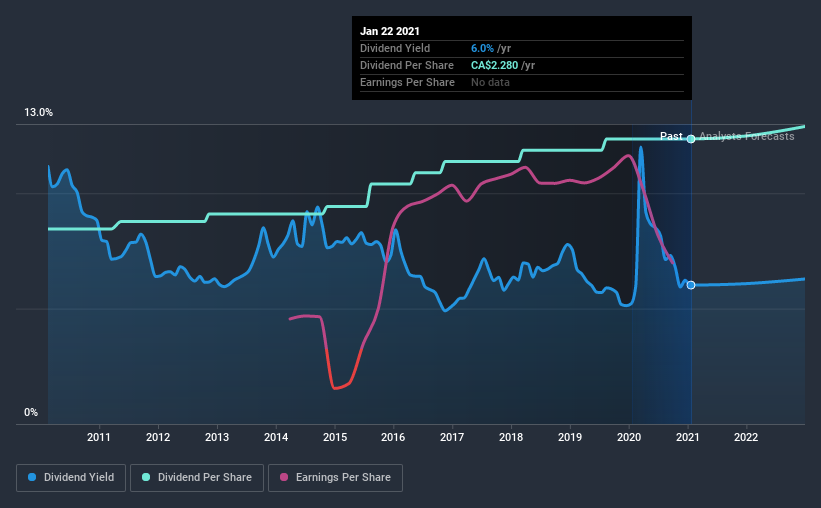Why It Might Not Make Sense To Buy Exchange Income Corporation (TSE:EIF) For Its Upcoming Dividend
Readers hoping to buy Exchange Income Corporation (TSE:EIF) for its dividend will need to make their move shortly, as the stock is about to trade ex-dividend. Ex-dividend means that investors that purchase the stock on or after the 28th of January will not receive this dividend, which will be paid on the 15th of February.
Exchange Income's upcoming dividend is CA$0.19 a share, following on from the last 12 months, when the company distributed a total of CA$2.28 per share to shareholders. Last year's total dividend payments show that Exchange Income has a trailing yield of 6.0% on the current share price of CA$37.88. Dividends are a major contributor to investment returns for long term holders, but only if the dividend continues to be paid. We need to see whether the dividend is covered by earnings and if it's growing.
View our latest analysis for Exchange Income
Dividends are usually paid out of company profits, so if a company pays out more than it earned then its dividend is usually at greater risk of being cut. Exchange Income distributed an unsustainably high 198% of its profit as dividends to shareholders last year. Without extenuating circumstances, we'd consider the dividend at risk of a cut. That said, even highly profitable companies sometimes might not generate enough cash to pay the dividend, which is why we should always check if the dividend is covered by cash flow. The company paid out 90% of its free cash flow over the last year, which we think is outside the ideal range for most businesses. Companies usually need cash more than they need earnings - expenses don't pay themselves - so it's not great to see it paying out so much of its cash flow.
Cash is slightly more important than profit from a dividend perspective, but given Exchange Income's payouts were not well covered by either earnings or cash flow, we would be concerned about the sustainability of this dividend.
Click here to see the company's payout ratio, plus analyst estimates of its future dividends.
Have Earnings And Dividends Been Growing?
Businesses with strong growth prospects usually make the best dividend payers, because it's easier to grow dividends when earnings per share are improving. If business enters a downturn and the dividend is cut, the company could see its value fall precipitously. With that in mind, we're encouraged by the steady growth at Exchange Income, with earnings per share up 3.8% on average over the last five years. Earnings are not growing much and Exchange Income paid out a lot more than it earned in profit last year. This makes the dividend look potentially unsustainable in the long run.
We'd also point out that Exchange Income issued a meaningful number of new shares in the past year. It's hard to grow dividends per share when a company keeps creating new shares.
The main way most investors will assess a company's dividend prospects is by checking the historical rate of dividend growth. Since the start of our data, 10 years ago, Exchange Income has lifted its dividend by approximately 3.9% a year on average. We're glad to see dividends rising alongside earnings over a number of years, which may be a sign the company intends to share the growth with shareholders.
To Sum It Up
Is Exchange Income worth buying for its dividend? The dividends are not well covered by either income or free cash flow, although at least earnings per share are slowly increasing. Overall it doesn't look like the most suitable dividend stock for a long-term buy and hold investor.
With that being said, if you're still considering Exchange Income as an investment, you'll find it beneficial to know what risks this stock is facing. We've identified 4 warning signs with Exchange Income (at least 1 which doesn't sit too well with us), and understanding them should be part of your investment process.
A common investment mistake is buying the first interesting stock you see. Here you can find a list of promising dividend stocks with a greater than 2% yield and an upcoming dividend.
This article by Simply Wall St is general in nature. It does not constitute a recommendation to buy or sell any stock, and does not take account of your objectives, or your financial situation. We aim to bring you long-term focused analysis driven by fundamental data. Note that our analysis may not factor in the latest price-sensitive company announcements or qualitative material. Simply Wall St has no position in any stocks mentioned.
Have feedback on this article? Concerned about the content? Get in touch with us directly. Alternatively, email editorial-team (at) simplywallst.com.

 Yahoo Finance
Yahoo Finance 
